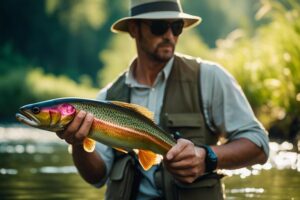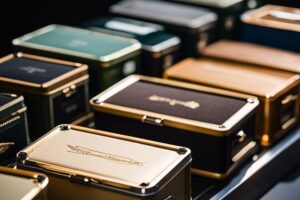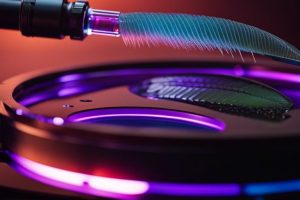Over the years, mastering the art of Euro nymphing has become important for catching fish in European waters. To succeed, you need to understand how to rig your leaders effectively. This technique relies on precision and sensitivity, allowing you to detect even the slightest of bites. In this guide, you will learn the key elements to create a well-balanced leader system, ensuring your nymphs drift naturally and sink quickly. By following these steps, you can enhance your fishing experience and increase your chances of landing more fish.
Choosing the Right Leader Material
A key element to effective European nymphing is selecting the right leader material. Your choice can significantly impact your ability to feel the slightest takes and maintain control during the drift. Understanding the benefits and drawbacks of each material—monofilament versus fluorocarbon—will help you tailor your setup to fit your fishing style and the conditions you encounter.
Monofilament vs. Fluorocarbon
Material selection often comes down to personal preference and fishing conditions. Monofilament is popular due to its buoyancy and elasticity, making it easier to manage on the water surface. It provides greater visibility for you to monitor your line, especially in choppy waters. However, this buoyant nature can be a double-edged sword; it may hinder your ability to achieve a direct connection with your nymphs as they drift closer to the bottom.
On the other hand, fluorocarbon presents significant advantages for European nymphing. It is dense and sinks rapidly, allowing your flies to reach the desired depth quickly. This can be especially critical when fishing faster or deeper waters. You’ll also find that fluorocarbon has a lower refractive index than monofilament, making it less visible underwater and enabling a stealthier presentation to wary fish.
Considerations for Euro Nymphing
Fluorocarbon is often preferred for nymphing due to its sensitivity and low visibility, enabling you to detect even the slightest strikes. It offers a direct connection to your flies, which is crucial for the Euro nymphing technique that relies on maintaining contact and feel. Be mindful of the stiffness that sometimes accompanies fluorocarbon; it may require a careful approach to avoid line twists when casting and retrieving.
Euro nymphing challenges you to adapt your technique based on the conditions you face. By choosing the right leader material, you equip yourself to maximize your effectiveness on the water. Note, the combination of sensitivity, invisibility, and sink rate in your leader can make all the difference in drawing bites from even the most finicky fish.
Leader Construction Basics
If you are new to Euro nymphing, understanding the foundation of leader construction is important for success on the water. The right leader can mean the difference between a day of frustration and one filled with connections. This technique hinges on achieving a delicate balance; your leader should be strong yet sensitive enough to detect the lightest takes. When setting up your leader, you need to consider materials, lengths, and diameters, which play a crucial role in effectively presenting your nymphs at the right depth and drift.
Building a Euro Nymphing Leader from Scratch
To build your own Euro nymphing leader, start with a strong, thin, and abrasion-resistant main line, usually made from fluorocarbon. A common choice is a mainline of about 0.20 to 0.25 mm for the running line, providing the necessary strength without sacrificing sensitivity. A typical leader length ranges from 10 to 15 feet; this added length helps with casting accuracy and control. Next, you’ll want to attach a tippet, which can be a lighter gauge tippet of around 0.12 to 0.18 mm. This will allow your nymph to drift naturally in the current.
Your tippet should taper down smoothly to ensure a delicate presentation. Some anglers prefer adding a piece of sighter material to the leader, often in bright colors, to improve visibility. This helps you keep track of your line and detect subtle strikes. The key is to create a leader that has enough stiffness to fish effectively while still maintaining the flexibility required for sensitive presentations.
Using Pre-Tied Leaders
With the growing popularity of Euro nymphing, many manufacturers now offer pre-tied leaders specifically designed for this technique. These leaders come ready to go and are often optimized for performance on the water. You find a variety of options, from leaders tailored for specific conditions to those with different tippet sizes based on the nymphs you plan to use.
Euro nymphing has made strides in simplifying the process for anglers of all skill levels. With pre-tied leaders, you can save time and ensure that your setup is effective right out of the package. This ease of use allows you to focus more on your technique and presentation, which ultimately improves your chances of success in the waters you fish.
Selecting the Optimal Leader Length
Even as you explore into the art of Euro nymphing, understanding the implications of leader length is crucial. The optimal leader length can significantly affect your drifting, hook sets, and overall success on the water. Key factors influencing your choice include water depth, current speed, and the size of the nymphs you’re using. A longer leader can provide better drift in deeper waters, while shorter leaders can be beneficial in shallower pockets. Elevate your technique by considering the following elements:
Factors Affecting Leader Length
- Water Depth: Deeper water typically requires longer leaders to reach nymphs effectively.
- Current Speed: Fast currents can necessitate shorter leaders for better control.
- Nymph Size: Larger nymphs often need a greater distance from the fly line to prevent drag.
- Your Casting Style: Adjust your leader length based on how you prefer to cast and mend.
Thou should also factor in personal comfort and experience when selecting your leader length. Experimenting with various lengths will help refine your approach, making you a more versatile angler.
Standard Leader Lengths for Euro Nymphing
One common standard for leader lengths in Euro nymphing is between 10 to 15 feet. Many anglers find that 11 to 12 feet provides a good balance for most fishing situations, offering more control and effective drifts in typical river conditions. However, the specific length you choose should also consider the type of water you are fishing. You may find shorter leaders more effective in certain faster currents, while longer ones are perfect for deeper, slower sections of the river.
Optimal leader lengths will ultimately hinge on your unique fishing circumstances and style. Familiarizing yourself with various scenarios will aid you in determining the best leader for each outing. Embrace the variability; it is what defines the art of Euro nymphing. Adjust as needed, and with practice, you will discover what inspires confidence in your fishing game.
Tippet Ring and Tippet Material Selection
Benefits of Tippet Rings
Your choice of a tippet ring can greatly enhance your Euro nymphing setup. These small but mighty tools serve as excellent connectors between your leader and tippet material. The tippet ring allows for easy changes to your tippet without the need to re-tie your entire leader, saving you valuable time on the water. Furthermore, tippet rings strengthen your connection, reducing the likelihood of breakage at knots under load. By using a tippet ring, you can maintain the integrity of your setup while effectively managing multiple tippet lengths for varying conditions.
On the European nymphing scene, the tippet ring has gained popularity for good reason. It facilitates improved line management by allowing you to quickly adjust your tippet length as needed, which is crucial when dealing with changing water conditions. Additionally, the presence of a tippet ring helps to minimize the size of any knots, which can be detrimental to your casting accuracy. By selecting a quality tippet ring, you’re setting yourself up for success on your next fishing adventure.
Choosing the Right Tippet Material
Tippet material is just as vital as the tippet ring when rigging for Euro nymphing. The right material can affect your drift, visibility, and overall effectiveness. You want a tippet that has a low memory, which allows it to remain straight and true in the water, making your nymphs appear more natural to fish. Fluorocarbon is an excellent choice due to its low visibility and sinking properties, while monofilament can provide a bit more stretch for accommodating sudden strikes.
The selection of tippet material involves considering the fishing conditions you expect to encounter. If you’re fishing clear, calm waters, you may opt for lighter tippet material that won’t spook the fish. In contrast, stained or fast-moving waters may require a slightly thicker diameter to withstand the stress of strong currents and aggressive fish. Always keep in mind that having a mix of tippet sizes on hand will provide you with flexibility in your approach, ensuring that you’re rigged and ready for whatever the day may throw at you.
Attaching the Fly to the Leader
For effective European nymphing, attaching your fly properly to the leader is crucial. You have several options, depending on your preference and the situation. You might want to explore different techniques to find what works best for you. A well-rigged leader enhances sensitivity and control, ultimately leading to more successful catches. For a deeper investigate leader configurations, you can check out Creating a Modular European Nymphing Leader – Fly Fishing.
Knotless Connection Methods
One popular method for attaching your fly is the use of knotless connections. These connections often employ loop-to-loop setups or micro swivels, which can enhance your line’s sensitivity and reduce the risk of tangles. With knotless connections, you can quickly swap flies during your outing, giving you versatility in your approach without the hassle of tying new knots. This method also maintains a straight connection, ensuring that you can feel every subtle bite.
Knot-Based Connection Methods
The traditional knot-based methods remain popular among many anglers for their simplicity and reliability. You can easily tie a few classic knots, such as the improved clinch knot or the Uni knot, to secure your fly to the leader. This approach provides a strong connection to your fly and gives you the confidence to fight that trophy fish without worrying about your tackle failing. Furthermore, knots are easy to learn and can be quickly tied, making them a great choice for those new to Euro nymphing.
Another effective knot-based method you might consider is the double fly rig. It allows you to tie two flies to your leader, increasing your chances of attracting fish while nymphing. Each fly can target different depths in the water column. With proper knot tying, you can ensure that each connection is secure and that your setup remains sleek and effective throughout your fishing experience. Experiment with both methods to see which suits your style best. Each has its merits, and the right technique may enhance your overall success on the water.
Leader Maintenance and Storage
Many anglers overlook the importance of leader maintenance, but proper care will extend the life of your leaders and improve your nymphing success. After each session, ensure you clean and dry your leaders thoroughly. Any moisture or debris left on the leader can lead to deterioration over time, affecting its performance while on the water. You can simply rinse your leaders in clean water to remove any dirt or sediment, and gently pat them dry with a soft cloth. This step is quick but crucial for preserving the integrity of the materials, especially if you fish in varied environments where mud and algae can cling to your lines.
Cleaning and Drying Leaders
When cleaning your leaders, pay attention to both the monofilament and any loops or connectors. These areas can trap dirt and debris, leading to potential weaknesses. A thorough drying process is equally important. If you pack away damp leaders, you risk not only degradation but also potential mold growth. Allow your leaders to air dry completely before storing them, ideally in a shaded area to prevent unnecessary exposure to sunlight which can weaken the material.
Storing Leaders for Future Use
With proper cleaning done, the next step is to focus on how you store your leaders for future sessions. Your leaders deserve a dedicated space where they can remain untangled and protected from elements that may cause them harm. Use a compartmentalized storage system or a simple leader wallet to keep them organized. This not only allows for easy accessibility but also prevents the leaders from becoming entwined, which can cause kinks and reduce performance. Make sure to label each leader for quick identification, so you can grab what you need without hassle when the time comes to hit the water.
Understanding how to store your leaders effectively also means considering the environment. If you’re keeping them in a vehicle or workshop, ensure they’re out of direct sunlight and away from extreme temperatures. These conditions can weaken the material over time. You might even consider using desiccants in your storage area to absorb any moisture. By prioritizing leader maintenance and storage, you prepare yourself for those days on the water where every cast counts.
Conclusion
The success of your Euro nymphing experience rests heavily on how well you rig your leaders. You must understand that the right combination of materials, weights, and lengths creates a system that enhances your ability to present flies at the ideal depth and retrieves them effectively. By paying attention to the nuances of leader construction, you can maximize your chances of connecting with fish lurking beneath the surface. Recall, a well-rigged leader not only improves your presentation but also helps you maintain control over your drift.
Your journey into Euro nymphing can be made more rewarding when your leaders are properly rigged. Equip yourself with the knowledge to adjust or modify your setup according to the conditions you face on the river. By doing so, you increase your adaptability as an angler and arm yourself with the tools to tackle ever-changing waters. Trust in your experience, enjoy the learning process, and let the simplicity of effective rigging bring you closer to the fish you seek.
FAQ
Q: What type of leader is best for Euro nymphing?
A: The ideal leader for Euro nymphing is typically a long, tapered leader that transitions to a thin, strong tippet. A common setup is to use a leader that is at least 10-12 feet in length, made from a material that sinks well, such as fluorocarbon. This allows the nymph to get down quickly and stay in the feeding zone. You might consider a leader with a diameter of around 0.20-0.25mm for the main line and then attach a tippet of about 0.12-0.16mm based on water conditions and fish size. The leader should have minimal stretch to enhance sensitivity and improve strike detection.
Q: How do I set up my Euro nymphing rig with multiple flies?
A: To set up a Euro nymphing rig with multiple flies, start by attaching your main line to a long, tapered leader. Tie a large enough fly, often referred to as a “point fly,” to the end of your tippet. Then, select a smaller “dropper fly” that you want to fish above the point fly. To attach the dropper, cut a length of tippet (around 18-24 inches) and tie it to your main tippet using a double surgeon’s knot or other compatible knot. The dropper should be located 12-18 inches above the point fly. Make sure that the weight of the flies is appropriate to ensure a good drift, and adjust the lengths based on the depth of water you are fishing.
Q: How can I adjust my leader for different water conditions while Euro nymphing?
A: Adjusting your leader for various water conditions is crucial for successful Euro nymphing. In faster or deeper waters, consider using a shorter leader, around 9-10 feet, with a heavier tippet and possibly a larger weight to get your flies down quickly. In slower or shallower waters, you might prefer a longer leader of 12-15 feet with a lighter tippet and smaller flies to allow for a more natural drift. Additionally, you may need to experiment with the length of your tippet and the distance between flies to optimize your rig based on how fish are reacting during your outing. Monitoring conditions like current speed and depth will help in making these adjustments effectively.


